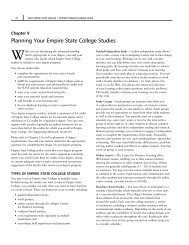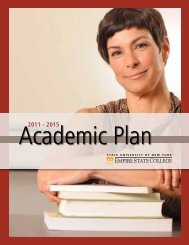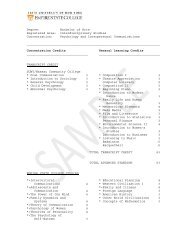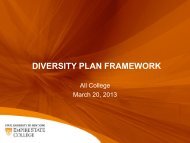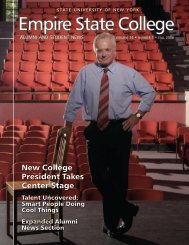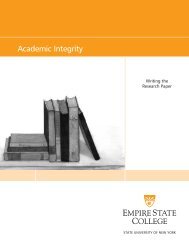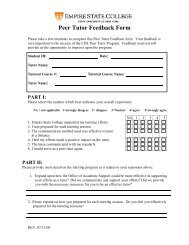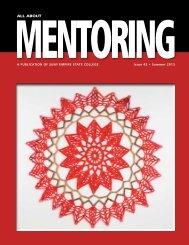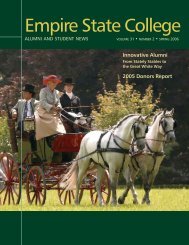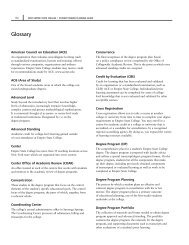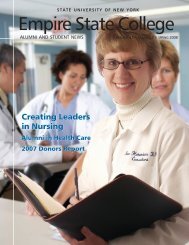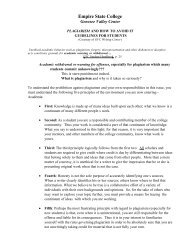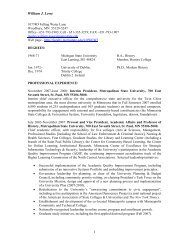All About Mentoring Spring 2011 - SUNY Empire State College
All About Mentoring Spring 2011 - SUNY Empire State College
All About Mentoring Spring 2011 - SUNY Empire State College
You also want an ePaper? Increase the reach of your titles
YUMPU automatically turns print PDFs into web optimized ePapers that Google loves.
14<br />
to research, create, disseminate and publish<br />
using these media. This lack of familiarity<br />
among faculty may lead to hesitation<br />
in adopting digital and social media for<br />
mentoring and learning.<br />
III. Defining Digital and<br />
Media Literacy<br />
In Digital and Media Literacy: A Plan<br />
of Action, author Renee Hobbs (2010)<br />
provides an excellent definition of digital<br />
and media literacy:<br />
The term ‘digital and media literacy’<br />
is used to encompass the full range<br />
of cognitive, emotional and social<br />
competencies that includes the use<br />
of texts, tools and technologies; the<br />
skills of critical thinking and analysis;<br />
the practice of message composition<br />
and creativity; the ability to engage<br />
in reflection and ethical thinking; as<br />
well as active participation through<br />
teamwork and collaboration. (p. 17)<br />
Hobbs further defines digital and media<br />
literacy “as a constellation of life skills that<br />
are necessary for full participation in our<br />
media-saturated, information-rich society.<br />
These include the ability to do the following:<br />
• Make responsible choices and access<br />
information by locating and sharing<br />
materials and comprehending information<br />
and ideas<br />
• Analyze messages in a variety of forms<br />
by identifying the author, purpose and<br />
point of view, and evaluating the quality<br />
and credibility of the content<br />
• Create content in a variety of forms,<br />
making use of language, images, sound,<br />
and new digital tools and technologies<br />
• Reflect on one’s own conduct and<br />
communication behavior by applying<br />
social responsibility and ethical principles<br />
• Take social action by working<br />
individually and collaboratively to<br />
share knowledge and solve problems in<br />
the family, workplace and community,<br />
and by participating as a member of a<br />
community.”(p. vii)<br />
Hobbs’s report proposes the following<br />
competencies of digital media literacy<br />
(p. 19):<br />
Essential Competencies of Digital and Media Literacy<br />
1. ACCESS Finding and using media and technology tools skillfully and sharing<br />
appropriate and relevant information with others<br />
2. ANALYZE and EVALUATE Comprehending messages and using critical<br />
thinking to analyze message quality, veracity, credibility and point of view,<br />
while considering potential effects or consequences of messages<br />
3. CREATE Composing or generating content using creativity and confidence<br />
in self-expression, with awareness of purpose, audience and composition<br />
techniques<br />
4. REFLECT Applying social responsibility and ethical principles to one’s own<br />
identity and lived experience, communication behavior and conduct<br />
5. ACT Working individually and collaboratively to share knowledge and solve<br />
problems in the family, the workplace and the community, and participating as<br />
a member of a community at local, regional, national and international levels<br />
IV. Digital Media Studies<br />
Digital, social and new media studies<br />
are growth areas attracting a changing<br />
demographic in arts and communications<br />
concentrators at the Center for Distance<br />
Learning. Academic area coordinators<br />
serving mentees in these areas are seeing<br />
a rise in students who matriculate with<br />
a large number of prior credits in arts,<br />
design and media studies, with a need for<br />
advanced-level studies in their concentration,<br />
and an interest in digital and new media.<br />
There were 204 combined admissions<br />
application inquiries for the areas of arts<br />
and communication (at CDL) between June<br />
and November 2010, a number that reflects<br />
the strongest area of interest for potential<br />
concentrators among the areas of The Arts,<br />
Cultural Studies, Historical Studies and<br />
Educational Studies. 1<br />
The rising interest in digital media studies<br />
reflects an ongoing interest from the general<br />
education student seeking digital and media<br />
literacy skills, as well as a new group of<br />
students needing advanced studies in digital<br />
media topics. Previously, CDL courses<br />
in the arts, digital media, and media and<br />
communications were designed to serve the<br />
general education student seeking to fulfill<br />
requirements. Our new mentees are arriving<br />
at CDL with either a large number of<br />
transcript credits in the arts from previous<br />
institutions, or extensive professional<br />
expertise in an artistic field. Some students<br />
are bringing both of these to the college,<br />
and are ready to move immediately into<br />
degree planning and undertake studies at<br />
an advanced level. These students share<br />
the common characteristic of having<br />
previous studio training in an artistic genre,<br />
sometimes at a very advanced level. They<br />
find themselves at a place in their career<br />
where they must either prepare for a career<br />
transition or acquire new, advanced skills<br />
and knowledge that will position them<br />
favorably for future opportunities. Many<br />
of these students are requesting new studies<br />
in digital arts and media. Most of them<br />
need to take these studies at an advanced<br />
level, including a capstone course in their<br />
concentration.<br />
As an academic area coordinator at the<br />
Center for Distance Learning, my role<br />
includes being a mentor and supervising<br />
adjunct instructors teaching sections of<br />
the courses under my purview. One of<br />
the difficulties encountered working with<br />
instructors is that they have different levels<br />
of skills and knowledge of emerging media<br />
and technology. I recently participated in<br />
a significant revision of a digital art and<br />
design course, which included the addition<br />
of ethical, legal, policy and social aspects of<br />
digital design, as well as the incorporation of<br />
social media as tools used by the students in<br />
suny empire state college • all about mentoring • issue 39 • spring <strong>2011</strong>




